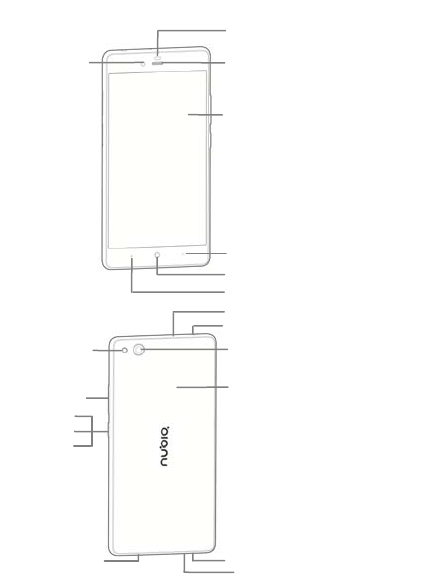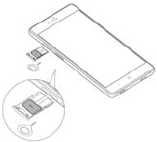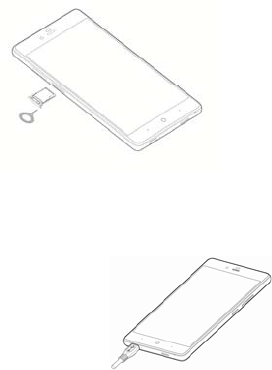ZTE NX512J LTE Digital Mobile Handset User Manual NX512J UserManual FCC
ZTE Corporation LTE Digital Mobile Handset NX512J UserManual FCC
ZTE >
User manual
- 1 -
NX512J
User Manual
- 2 -
Copyright Statement
Copyright © 2015 by Nubia Technology Co., Ltd.
All rights reserved.
The copyrights of this document are owned by Nubia
Technology Co., Ltd. No part of this publication may be
quoted, reproduced, translated or used in any form or by
any means, electronic or mechanical, including
photocopying and microfilm, without the prior written
permission of Nubia Technology Co., Ltd.
Nubia Technology Co., Ltd. reserves the right to make
modifications on print errors or update specifications in this
document without prior notice.
Nubia Technology Co., Ltd. reserves all the right for the
final explanation of this document.
Trademarks
Android is a trademark of Google, Inc.
Third-party Applications Statement
During the installation process of some third-party
applications, the issues of repeated restart or abnormal
use of software might be caused by incompatibility of the
third-party applications, rather than the phone itself.
Please download your software upgrade packages from
the reliable official website.
The installation of a third-party ROM or non-official
operating system might bring safety risks and security
threats. Nubia Technology Co., Ltd. shall not be liable for
these risks and threats caused by upgrade of the operating
system.

- 3 -
Receiver
Front camera
LCD
Menu key
Home key
Back key
Headset
j
ack
Back camera
Power
Reset
Lock key
Noise-reduction MIC
Speaker
Light/proximity sensor
Volume ke
y
Flashlight
MIC
USB port
NFC Sensing area
Appearance

- 4 -
Inserting and removing a SIM card
1. Insert the card
ejection tool into the
small hole on your
card tray; slightly
press inward to eject
the tray.
2. Install your SIM card on the tray and push it back to
the original position.
Please follow the step 1 above and take out your SM card
when you need remove it.
Your phone adopts nano-SIM card, which is a micro SIM
card which functions the same as a normal SIM card. The
dimensions of a nano-SIM card are 12mm*9mm.
Note:
1. Please insert a standard nano-SIM card.
2. Please do not use a non-standard card or cut your
card manually.
3. Please do not insert the memory card tray into the
nano-SIM card slot.
Inserting and removing a Memory
card
1. Insert the card ejection tool into the small hole on your
card tray; slightly press inward to eject the tray.
2. Install your memory card on the tray and push it back
to the original position.
Please follow the step 1 above and take out your memory
card when you need remove it.

- 5 -
Charing the battery
Connect your charger to
your phone using a USB
cable, and plug in your
charger to a standard
power socket. Please
pay attention to the
direction of the USB port
and insert the USB cable into your phone correctly.
Note: Please do not dismantle the product by yourself.
Contact your local after-sales distributor if necessary.
- 6 -
Health and safety
FCC Regulations:
This mobile phone complies with part 15 of the FCC Rules.
Operation is subject to the following two conditions: (1)
This device may not cause harmful interference, and (2)
this device must accept any interference received,
including interference that may cause undesired operation.
This mobile phone has been tested and found to comply
with the limits for a Class B digital device, pursuant to Part
15 of the FCC Rules. These limits are designed to provide
reasonable protection against harmful interference in a
residential installation. This equipment generates, uses
and can radiated radio frequency energy and, if not
installed and used in accordance with the instructions, may
cause harmful interference to radio communications.
However, there is no guarantee that interference will not
occur in a particular installation If this equipment does
cause harmful interference to radio or television reception,
which can be determined by turning the equipment off and
on, the user is encouraged to try to correct the interference
by one or more of the following measures:
-Reorient or relocate the receiving antenna.
-Increase the separation between the equipment and
receiver.
-Connect the equipment into an outlet on a circuit different
from that to which the receiver is connected.
-Consult the dealer or an experienced radio/TV technician
for help.
FCC Note:
Caution: Changes or modifications not expressly approved
by the party responsible for compliance could void the
user‘s authority to operate the equipment.
RF exposure information (SAR)
- 7 -
This phone is designed and manufactured not to exceed
the emission limits for exposure to radio frequency (RF)
energy set by the Federal Communications Commission of
the United States.
During SAR testing, this device was set to transmit at its
highest certified power level in all tested frequency bands,
and placed in positions that simulate RF exposure in usage
against the head with no separation, and near the body
with the separation of 10 mm. Although the SAR is
determined at the highest certified power level, the actual
SAR level of the device while operating can be well below
the maximum value. This is because the phone is
designed to operate at multiple power levels so as to use
only the power required to reach the network. In general,
the closer you are to a wireless base station antenna, the
lower the power output.
The exposure standard for wireless devices employing a
unit of measurement is known as the Specific Absorption
Rate, or SAR.
The SAR limit set by the FCC is 1.6W/kg.
This device is complied with SAR for general population
/uncontrolled exposure limits in ANSI/IEEE C95.1-1992
and had been tested in accordance with the measurement
methods and procedures specified in IEEE1528. This
device has been tested and meets the FCC RF exposure
guidelines when tested with the device directly contacted to
the body.
The FCC has granted an Equipment Authorization for this
model phone with all reported SAR levels evaluated as in
compliance with the FCC RF exposure guidelines. SAR
information on this model phone is on file with the FCC and
can be found under the Display Grant section of
www.fcc.gov/oet/ea/fccid after searching on FCC ID:
SRQ-NX512J.
For this device, the highest reported SAR value for usage
against the head is 0.224 W/kg, for usage near the body is
- 8 -
1.361 W/kg.
While there may be differences between the SAR levels of
various phones and at various positions, they all meet the
government requirements.
SAR compliance for body-worn operation is based on a
separation distance of 10 mm between the unit and the
human body. Carry this device at least 10 mm away from
your body to ensure RF exposure level compliant or lower
to the reported level. To support body-worn operation,
choose the belt clips or holsters, which do not contain
metallic components, to maintain a separation of 10
mm between this device and your body.
RF exposure compliance with any body-worn accessory,
which contains metal, was not tested and certified, and use
such body-worn accessory should be avoided.
- 9 -
Declaration of RoHS compliance
We’re determined to reduce the impact we have on the
environment and take responsibility for the earth we live on.
So this document allows us to formally declare that the
nubia NX512J, manufactured by Nubia Technology Co.,
Ltd. fully complies with the European Parliament’s RoHS
(Restriction of Hazardous Substances) Directive
2002/95/EC, with respect to all the following substances:
(1) Lead (Pb)
(2) Mercury (Hg)
(3) Cadmium (Cd)
(4) Hexavalent Chromium (Cr (VI))
(5) Polybrominated biphenyl (PBB)
(6) Polybrominated diphenyl ether (PBDE)
Our compliance is witnessed by written declaration from
our suppliers. This confirms that any potential trace
contamination levels of the substances listed above are
below the maximum level set by EU 2002/95/EC, or are
exempt due to their application.
The nubia NX512J manufactured by Nubia Technology Co.,
Ltd. meets all the requirements of EU 2002/95/EC.

- 10 -
Disposal of your old phone
1. When the wheelie bin symbol is
attached to a product, it means the
product is covered by the European
Directive 2002/96/CE.
2. All electrical and electronic products
should be disposed of separately from
normal household waste via
designated collection points provided
by government or local authorities.
3. The correct disposal of electrical and
electronic products will help protect the
environment and human health.